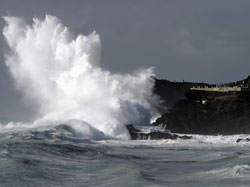
Physical Feature: Large wave events
The Hawaiian Islands are famous for their epic waves, particularly along the island's northern shores. Powerful winter storm events in the North Pacific cause high velocity winds which transfer their energy to surface waters over several hundred miles (called the "fetch"), thereby creating huge swells that radiate across the Pacific and shoal up on the Hawaiian Islands. The Northwestern Hawaiian islands are not immune to this energetic onslaught and many of the geologic features of the islands and atolls are testament to these forces. Giant spur and groove reef formations are seen along the Northern edges of most atolls, and massive undercutting is evident along cliff faces on the still high basalt islands of Mokumanamana and Nihoa. This wave energy partially defines coral growth and formation on exposed reefs, and also limits shallow water marine research activity in the region to the summer months (~May through September). Since Hawaiian atolls rise up steeply from abyssal depths, these huge waves crash directly onto shallow reefs, as opposed to breaking far offshore, and generally would not be that great for surfing. Surfing is not allowed in Monument waters, but even if it were, it would likely be extremely hazardous - not to mention all the sharks. (I know people were going to ask so I had to throw this in!)
Click Here for more information.

